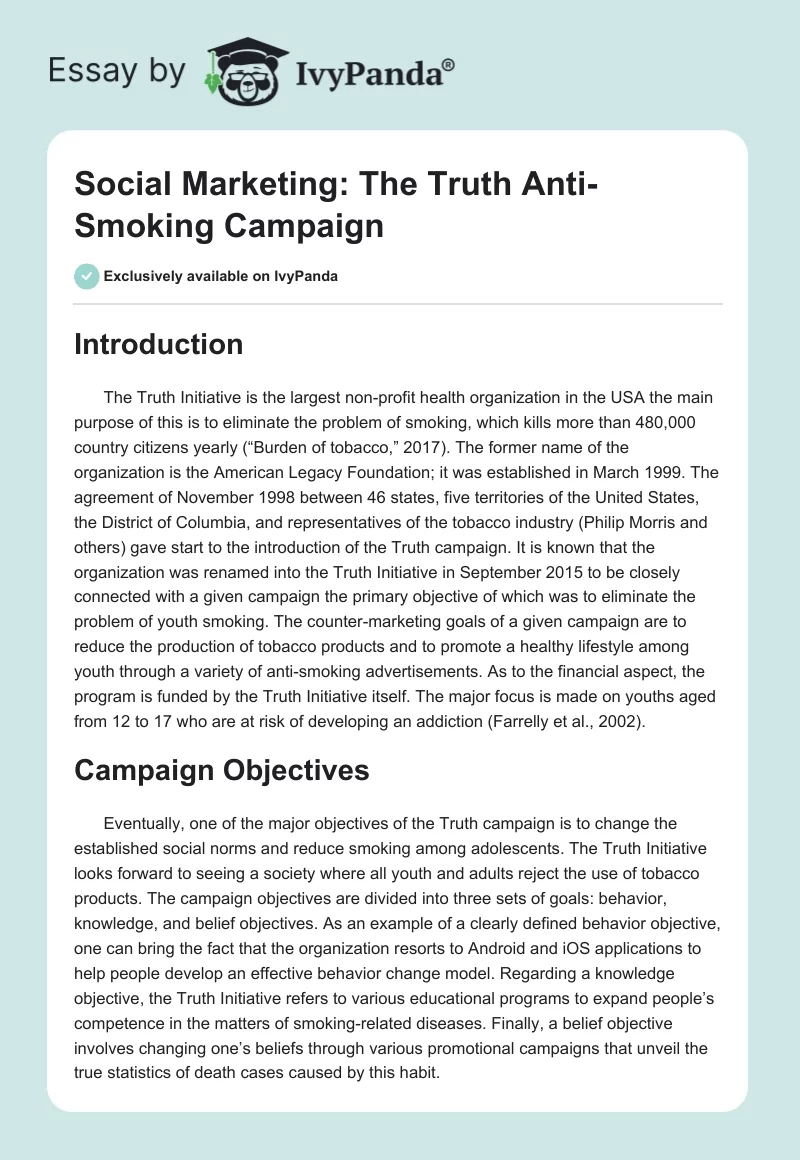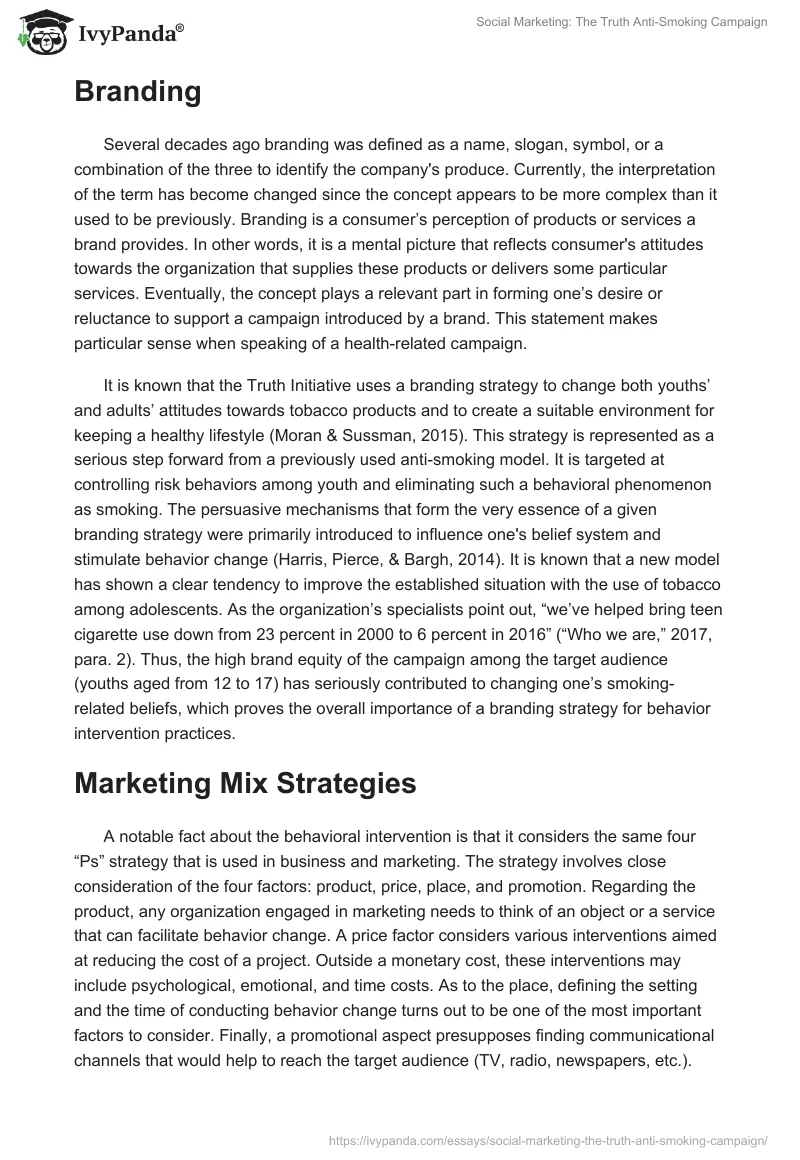Introduction
The Truth Initiative is the largest non-profit health organization in the USA the main purpose of this is to eliminate the problem of smoking, which kills more than 480,000 country citizens yearly (“Burden of tobacco,” 2017). The former name of the organization is the American Legacy Foundation; it was established in March 1999.
The agreement of November 1998 between 46 states, five territories of the United States, the District of Columbia, and representatives of the tobacco industry (Philip Morris and others) gave start to the introduction of the Truth campaign. It is known that the organization was renamed into the Truth Initiative in September 2015 to be closely connected with a given campaign the primary objective of which was to eliminate the problem of youth smoking. The counter-marketing goals of a given campaign are to reduce the production of tobacco products and to promote a healthy lifestyle among youth through a variety of anti-smoking advertisements. As to the financial aspect, the program is funded by the Truth Initiative itself. The major focus is made on youths aged from 12 to 17 who are at risk of developing an addiction (Farrelly et al., 2002).
Campaign Objectives
Eventually, one of the major objectives of the Truth campaign is to change the established social norms and reduce smoking among adolescents. The Truth Initiative looks forward to seeing a society where all youth and adults reject the use of tobacco products. The campaign objectives are divided into three sets of goals: behavior, knowledge, and belief objectives. As an example of a clearly defined behavior objective, one can bring the fact that the organization resorts to Android and iOS applications to help people develop an effective behavior change model. Regarding a knowledge objective, the Truth Initiative refers to various educational programs to expand people’s competence in the matters of smoking-related diseases. Finally, a belief objective involves changing one’s beliefs through various promotional campaigns that unveil the true statistics of death cases caused by this habit.
Branding
Several decades ago branding was defined as a name, slogan, symbol, or a combination of the three to identify the company’s produce. Currently, the interpretation of the term has become changed since the concept appears to be more complex than it used to be previously. Branding is a consumer’s perception of products or services a brand provides. In other words, it is a mental picture that reflects consumer’s attitudes towards the organization that supplies these products or delivers some particular services. Eventually, the concept plays a relevant part in forming one’s desire or reluctance to support a campaign introduced by a brand. This statement makes particular sense when speaking of a health-related campaign.
It is known that the Truth Initiative uses a branding strategy to change both youths’ and adults’ attitudes towards tobacco products and to create a suitable environment for keeping a healthy lifestyle (Moran & Sussman, 2015). This strategy is represented as a serious step forward from a previously used anti-smoking model. It is targeted at controlling risk behaviors among youth and eliminating such a behavioral phenomenon as smoking. The persuasive mechanisms that form the very essence of a given branding strategy were primarily introduced to influence one’s belief system and stimulate behavior change (Harris, Pierce, & Bargh, 2014). It is known that a new model has shown a clear tendency to improve the established situation with the use of tobacco among adolescents. As the organization’s specialists point out, “we’ve helped bring teen cigarette use down from 23 percent in 2000 to 6 percent in 2016” (“Who we are,” 2017, para. 2). Thus, the high brand equity of the campaign among the target audience (youths aged from 12 to 17) has seriously contributed to changing one’s smoking-related beliefs, which proves the overall importance of a branding strategy for behavior intervention practices.
Marketing Mix Strategies
A notable fact about the behavioral intervention is that it considers the same four “Ps” strategy that is used in business and marketing. The strategy involves close consideration of the four factors: product, price, place, and promotion. Regarding the product, any organization engaged in marketing needs to think of an object or a service that can facilitate behavior change. A price factor considers various interventions aimed at reducing the cost of a project. Outside a monetary cost, these interventions may include psychological, emotional, and time costs. As to the place, defining the setting and the time of conducting behavior change turns out to be one of the most important factors to consider. Finally, a promotional aspect presupposes finding communicational channels that would help to reach the target audience (TV, radio, newspapers, etc.).
In the case of the Truth campaign, the website (www.thetruth.com) and the information it contains are viewed as the product of a given strategy (“Who we are,” 2017). The price aspect is represented by the use of a cost-effective method of intervention: “while drawing youths to “truth,” the campaign delivers stark facts about tobacco industry marketing practices, rather than sending directive “just say no” messages” (Farrelly et al., 2002, p. 901). Also, campaign costs become reduced due to annual payments that cigarette manufacturers pay to the states (Xu et al., 2015). Regarding the place, the campaign began in 1998 and covered the entire territory of the United States. As was earlier mentioned, 46 states, the District of Columbia, and five territories of the USA were engaged in signing the Tobacco Master Settlement Agreement (Healton, 2001). Promotion activities involved launching TV and print commercials and using various promotional items, such as stickers, T-shirts, and banners (Farelly et al., 2002).
Each of the mentioned factors carries a huge meaning for overall campaign effectiveness. One cannot draw the audience’s attention without a clearly defined product, which arrives as a synthesis of organizational knowledge and experience. Also, knowledge transferring is impossible without an efficient price strategy used to regulate the campaign costs, for higher program costs may lead to the untimely project termination. Also, one needs to have a clearly outlined setting or a place to monitor the program implementation. However, to make a program work, an organization is supposed to conduct a properly planned promotion campaign since effective intervention is only possible when people get familiar with its principles.
Evaluation
The Truth Initiative used the Legacy Media Tracking Survey (LMTS) for evaluating the results of its anti-smoking campaign (Moran & Sussman, 2015). The first survey was conducted in 1999 before the campaign launch. The LMTS was an ideal measurement instrument since it allowed the evaluators to quickly assess responses and to continue surveying on an ongoing basis. The survey also incorporated measures achieved through the Elaboration Likelihood Model (ELM), which was always used to examine changes in attitude. The combination of evaluation tools was an important decision in the matters of data retrieving: owing to the two combined methods media planners received rapid feedback on how fast campaign messages were delivered to youth. In its turn, it allowed one to take different approaches to information delivery depending on the situation in behavior change practice (Moran & Sussman, 2015). It is known that in 2005 the organization shifted to the Legacy Media Tracking Online (LMTO) data collection tool. The tool performed the same function LMTS did only used more advanced mechanisms of data retrieval.
Barriers
Litigations arrive as a barrier that takes too much time and effort to overcome. The tobacco industry has shown a clear intent to obstruct the Legacy’s counter-marketing campaigns through numerous court procedures. This long-lasting legal battle creates plenty of challenges for the Truth Initiative to successfully implement a chosen program. Another obstacle is the anti-smoking campaign introduced by the tobacco industry itself (such as Philip Morris’s “Think. Don’t Smoke”). This campaign delivers information in such a way that teenagers start to view smoking as a habit, which is only harmful to teens, not to adults (Farelly et al., 2002). Eventually, such a form of subject interpretation seriously interferes with the Initiative’s plans to reduce smoking among adolescents. Thus, the Truth campaign achievements appear to be less successful
Conclusion
As derived from the outcomes of the research, an anti-smoking campaign launched by the Truth Initiative has proven its effectiveness through the use of a well-structured interventional program and the properly defined counter-marketing goals. Despite the fact, the campaign meets serious barriers, such as litigations and alternative anti-smoking campaigns, it has still the potential to eliminate the problem of tobacco use among adolescents. The statistics demonstrate that smoking among youth has reduced from 20% to 6% over 16 years. As a recommendation to the initiative, one can suggest that an advertising campaign continues to gain speed. Also, the program needs to gain legislators’ support to effectively withstand the attacks of the tobacco industry.
References
Burden of tobacco use in the U.S.(2017). Web.
Farrelly, M. C., Healton, C. G., Davis, K. C., Messeri, P., Hersey, J. C., & Haviland, M. L. (2002). Getting to the truth: evaluating national tobacco countermarketing campaigns. American Journal of Public Health, 92(6), 901-907.
Harris, J. L., Pierce, M., & Bargh, J. A. (2014). Priming effect of antismoking PSAs on smoking behaviour: A pilot study. Tobacco Control, 23(4), 285-290.
Healton, C. (2001). Who’s afraid of the truth? American Journal of Public Health, 91(4), 554-558.
Moran, M. B., & Sussman, S. (2015). Changing attitudes toward smoking and smoking susceptibility through peer crowd targeting: more evidence from a controlled study. Health Communication, 30(5), 521-524.
Who we are and what we do. (2017). Web.
Xu, X., Alexander, R. L., Simpson, S. A., Goates, S., Nonnemaker, J. M., Davis, K. C., & McAfee, T. (2015). A cost-effectiveness analysis of the first federally funded antismoking campaign. American Journal of Preventive Medicine, 48(3), 318-325.


